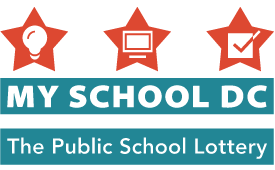Do I need to apply through the lottery?
You must submit an application if you want your child to be a NEW student at a:
- Participating public charter school for any grade (PK3 – grade 12);
- PK3 or PK4 program at any DCPS school, including your DCPS in-boundary school;
- Dual-language strand at your DCPS in-boundary elementary school (PK3 – grade 5). See list of schools here
- DCPS school outside your boundary or feeder pattern* for any grade (PK3 – grade 12), including DCPS citywide schools;
- DCPS selective high school or program (grades 9–12)
You do NOT need to submit an application if your child will:
- Remain in your current school. In this case simply contact your current school to re-enroll;
- Enroll at your DCPS in-boundary, geographic or programmatic feeder school* (grades K-12);
- Enroll at your public charter feeder school (if applicable)
*If you moved out-of-boundary from your DCPS school and lost your right to the middle or high school feeder school, you will need to apply to it. See DCPS Enrollment and Lottery Handbook for details.
Note: Only DCPS schools and public charter schools that serve PK3 – grade 12 participate in the My School DC lottery. For options outside of the lottery, such as PK community-based programs, DCPS Opportunity Academies, or adult public charter schools, click here.
How many schools can I apply to in the lottery?
For each student, you may apply to as few as one, or as many as 12 schools. You cannot apply to more than 12 schools. Click here to view lottery data from prior years, including seats made available in the lottery by school and grade. The more schools you apply to, the better the chance of getting a match to one of your school choices. However, only apply to schools you want your child to attend.
Tip: Use the School Finder to begin your school search. If you are interested in a school option for your child, add it to your lottery application by the required deadline and rank it in the order you prefer most amongst your other school selections.
How does the lottery matching work?
The two most important things to know about the program are:
- Students should rank schools in the order they prefer to increase their chances of being matched to their desired school.
- Students who apply early get no advantage in the matching process.
The lottery program follows the below process for all schools:*
The program assigns each student a random lottery number and attempts to match each student with their 1st choice first. If the program is unable to match a student at their 1st choice, it will then attempt to match them at their 2nd choice, then their 3rd, and so on in the order listed on the application. However, when it compares two students who have applied to the same school option, the decision is based on two criteria:
(1) The students’ lottery preferences at that school (e.g., sibling preference); and
(2) The students’ randomly assigned lottery number.
The student’s ranking of the schools is critical – it informs the order that the algorithm tries to match students in. However, it is not a factor in whether the student should or will get matched. In other words, the system does not try to fill a school’s seats with students who ranked them highest first. This is why the system is strategy-proof and why students are best served by ranking schools according to their true preference.
After identifying the highest ranked match possible for a student, the algorithm uses the student’s ranking to determine which waitlists to place the student on. Each student is placed on a waitlist at every school they ranked higher than the school at which they are matched. Exception: Siblings who apply to the same schools are placed on a waitlist at any school where one of their siblings is matched regardless if that school is ranked lower on a sibling’s application than where they are matched.
It is possible for a student not to receive a school match in the lottery due to space availability and demand. If a student is not matched to a school, they are placed on the waitlist at every school on their list.
*DCPS selective high schools and programs admit students based on specific criteria. Each of the selective high schools identifies which applicants meet their specific minimum requirements, and then each school determines the order of priority among that group. The lottery program uses the same process described above based upon the student’s ranking, and students will not be matched to more than one school. If a selective high school determines that a student is ineligible to attend, the lottery program will skip this school in the student’s rankings and try to match the student as the next highest ranked school and so forth.
Note: The student’s ranking of their school choices on the My School DC application may include any combination of DCPS schools and public charter schools. However, when the program is comparing two students who have applied to the same DCPS selective high school, the decision is made based on the school’s order of priority for the applicants.
Does the way I rank my schools on the application matter?
Yes, the way you rank your schools on the My School DC application matters because:
- The lottery system tries to match students with their choices in the order in which they’re listed, 1st, 2nd, 3rd etc., all the way through 12.
- After making a match, the program will add the student’s name to the waitlist of those schools that were ranked above the matched school.
- All schools ranked below the matched school are removed because they are less preferred than the matched school.
- If a student is not matched at any school, they will be placed on a waitlist at every school they listed.
There are only two exceptions to this: (1) DCPS selective high schools and programs, and (2) if an applicant's sibling is matched through the lottery.
- If a DCPS selective high school or program finds a student not eligible, they will not be placed on the waitlist for that school option regardless of how the student ranked the school.
- After being matched, an applicant will be placed on the waitlist for any school their sibling is matched to even if it is a school ranked below the matched school.
Will schools be able to see how I ranked them on my application?
No. My School DC does not give this information to schools.
Will the school my child is currently enrolled in be notified that I am submitting an application through the lottery?
No. My School DC does not notify students' current schools. Additionally, submitting a My School DC application does not impact your child’s enrollment at their current school.
How do lottery preferences work?
Students that qualify for a preference at a particular school are offered a space at that school before students who don’t have a preference, or receive a higher waitlist placement than students without a preference. Preferences act as tie-breakers: if there are more students than spaces in a particular grade at a school, the lottery will match students in order of their preference groups. Within preference groups, ties are broken by random lottery number.
Each charter school can determine which preferences are offered at their school and the order that those preferences are offered. However, for most DCPS schools the order is:
1. In-boundary with a sibling already attending the school (PK3 and PK4 only)
2. In-boundary with a sibling offered (PK3 and PK4 only)
3. In-boundary (PK3 and PK4 only)
4. Out-of-boundary with a sibling already attending the school
5. Out-of-boundary with a sibling offered
6. Proximity Preference (PK3 – grade 5 only)
7. Out-of-boundary applicant (with no other preference)
At DCPS dual language schools or programs, out-of-boundary siblings are prioritized before in-boundary applicants without siblings. DCPS citywide schools and public charter schools do not offer in-boundary or proximity preferences, and DCPS selective high schools and programs do not offer any preferences.
The preferences that a school offers are listed on its My School DC school profile. Please contact a school directly if you have a question about their preference order. Learn more about preferences here.
How you rank a school does not impact whether you are eligible for a preference at that school
Can my child who is applying to attend their DCPS in-boundary PK program claim sibling preference if their older sibling will be enrolling at the school for the first time in school year 2026-27?
Yes. If the student will attend and does not currently have a student ID number, input “0000000” (seven 0’s) as the student ID number in the Sibling Preference section of application. This option is only available to families planning on enrolling an in-boundary student. If you do not enroll the compulsory aged student, the preference will be removed from the PK student who may lose the match and be placed on the waitlist without the preference. Confirm with the school’s registrar, or within the application itself using the preference status page, that this preference has been applied prior to the lottery. After the lottery, these preferences are applied only when the older sibling is enrolled.
Please contact the DCPS Enrollment Team at [email protected] or (202) 478-5738 for additional information prior to the application deadlines. DCPS's sibling information can also be found in their Enrollment and Lottery Handbook.
Do all schools take new students in every grade they serve?
Most schools accept applications from new students in all grades (although space may be limited in some grades) and some schools only accept applications for new students at certain grades. You may view this information on the list of participating schools, and each My School DC school profile also notes the grades for which schools accept applications. To view seats made available in past years’ lotteries by school and grade, click here.
What are age cutoffs and cutoff dates?
- PK3 must be 3 years old by September 30, 2026;
- PK4 must be 4 years old by September 30, 2026; and
- Kindergarten must be 5 years old by September 30, 2026.





